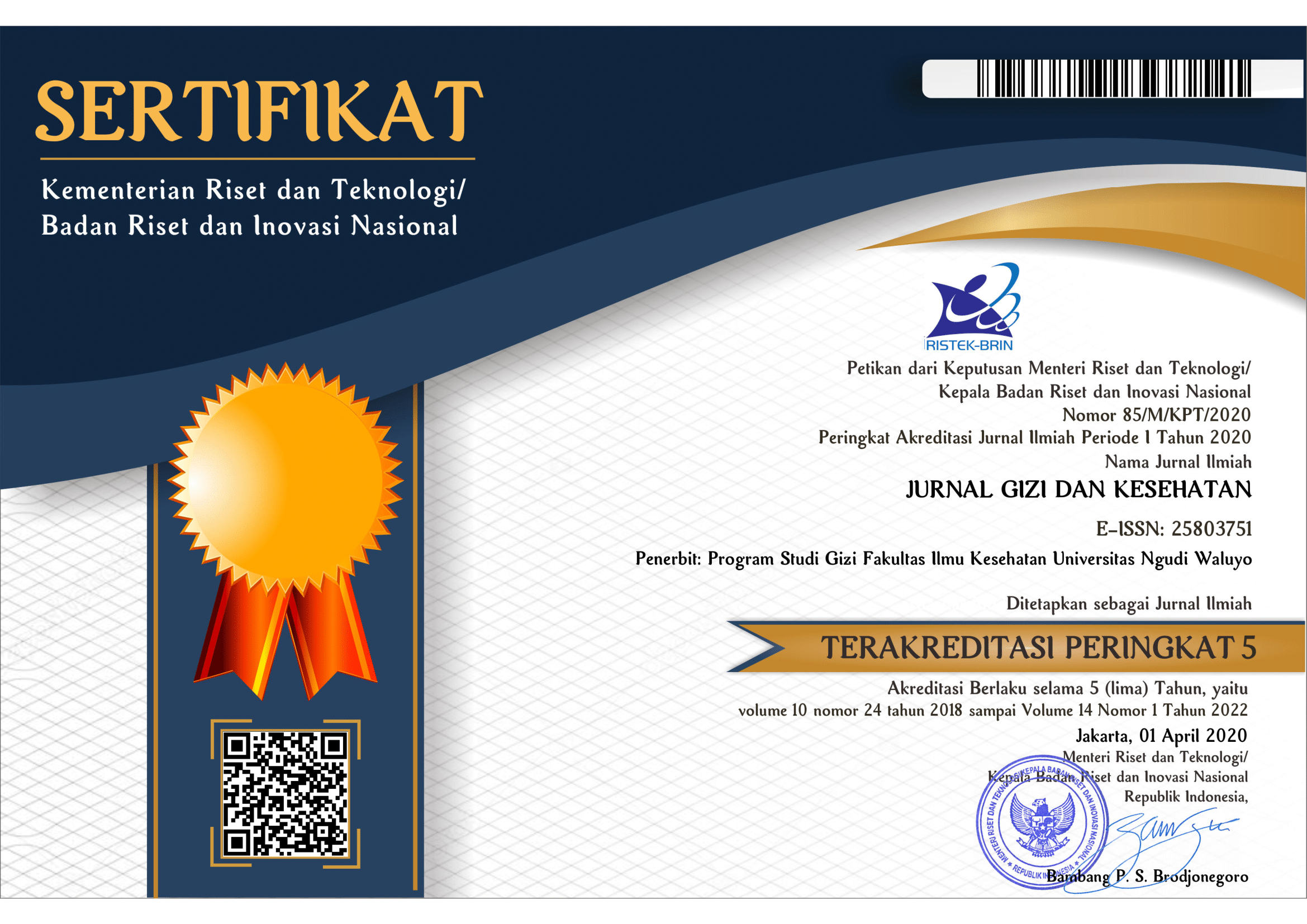Potret Penyakit Hipertensi dan Diabetes Melitus pada Usia Lanjut: Studi Potong Lintang di Kota Yogyakarta
Portrait of Hypertension and Diabetes Mellitus Diseases in the Elderly: A Cross-Sectional Study in Yogyakarta City
DOI:
https://doi.org/10.35473/jgk.v16i2.552Keywords:
Status Gizi Lansia, PTM, Pengurus PDM, Hipertensi, DMAbstract
The number of elderly people in Yogyakarta continues to increase but the problems of old age are increasingly complex such as increasing chronic diseases, decreased physical, mental, and cognitive functions. Comprehensive elderly health care is increasingly needed. The purpose of this study was to determine the description of hypertension and diabetes mellitus and their risk factors in the elderly. This study uses quantitative methods with a cross sectional design. The research sample was representatives of the elderly in Yogyakarta City who were members of the Muhammadiyah Branch Leadership of Yogyakarta City. The sampling technique was done purposively and obtained 21 people. Risk factors for hypertension and diabetes mellitus were measured using a structured questionnaire. Height, weight, blood pressure, blood sugar levels were measured directly by the nurse. Respondents who had a history of hypertension were 47.6% and respondents who had diabetes millitus were 14.3%. Men have a higher percentage of hypertension and diabetes mellitus than women. Physical activity, BMI, and smoking behavior have almost the same percentage to experience hypertension and DM. Fruit and vegetable eating patterns of respondents who were < 3 times had a higher percentage to experience hypertension and diabetes mellitus. Men have a higher percentage of hypertension and diabetes mellitus than women. Health promotion efforts on behavior change in the community need to be done so that risk factors change into protective factors.
ABSTRAK
Jumlah usia lanjut di Yogyakarta terus mengalami peningkatan namun permasalahan usia lanjut semakin komplek seperti meningkatnya penyakit kronis, penurunan fungsi fisik, mental, dan kognitif. Perawatan kesehatan kesehatan lansia yang bersifat komprehensif semakin diperlukan. Penelitian ini untuk mengetahui gambaran penyakit hipertensi dan diabetes melitus serta faktor risikonya pada lansia. Penelitian ini menggunakan metode kuantitatif dengan rancangan cross sectional. Sampel penelitian adalah perwakilan lansia di Kota Yogyakarta yang tergabung dalam Pimpinan Cabang Muhammadiyah Kota Yogyakarta. Teknik sampling dilakukan secara purposive dan diperoleh 21 orang. Faktor risiko penyakit hipertensi dan diabetes melitus diukur menggunakan kuesioner terstruktur. Tinggi badang, berat badan, tekanan darah, kadar gula darah dilakukan pengukuran langsung oleh perawat. Responden yang memiliki riwayat hipertensi sebesar 47,6% dan responden yang memiliki diabetes millitus sebesar 14,3%. Laki-laki memiliki persentase lebih tinggi untuk mengalami hipertensi dan diabetes melitus dibandingkan perempuan. Aktivitas fisik, IMT, dan perilaku merokok memiliki persentase yang hampir sama untuk mengalami hipertensi dan DM. Pola makan buah dan sayur responden yang < 3 kali memiliki persentasae lebih tinggi untuk mengalami hipertensi dan diabetes melitus. Laki-laki memiliki persentase lebih tinggi untuk mengalami hipertensi dan diabetes melitus dibandingkan perempuan. Upaya promosi kesehatan tentang perubahan perilaku dimasyarakat perlu dilakukan agar faktor risiko berubah menjadi faktor protektif.
Downloads
References
Ahmed, M.T., Jadhav, J. and Sobagaiah, R.T. (2018) ‘Assessment of risk factors of non-communicable diseases among healthcare workers in Nelamangala: a cross sectional study’, International Journal Of Community Medicine And Public Health, 5(2), p. 745. Available at: https://doi.org/10.18203/2394-6040.ijcmph20180261.
Angelina, C., Yulyani, V. and Efriyani, E. (2021) ‘Faktor-Faktor yang Mempengaruhi kejadian Hipertensi di Puskesmas BIHA Pesisir Barat Tahun 2020’, E-Indonesian Journal of Helath and Medical, (1), pp. 2774–5244.
Asri, I.P. et al. (2022) ‘Analisis Faktor Risiko Kejadian Hipertensi di Wilayah Kota Depok’, Journal of Public Health Education, 1(3), pp. 170–184. Available at: https://doi.org/https://doi.org/10.53801/jphe.v1i3.51.
Astuti, A. (2019) ‘Usia, Obesitas dan Aktifitas Fisik Beresiko Terhadap Prediabetes’, Jurnal Endurance, 4(2), p. 319.
Avicenna (1973) The Canon of Medicine of Avicenna. New York (USA.
Ayu Susilowati, A. et al. (2019) ‘Pengaruh Pola Makan Terhadap Potensi Resiko Penyakit Diabetes Melitus’,’ Jurnal Mandala Pharmacon Indonesia, (5), p. 1.
Budreviciute, A. et al. (2020) ‘Management and Prevention Strategies for Non-communicable Diseases (NCDs) and Their Risk Factors’, Frontiers in Public Health, 8(November), pp. 1–11. Available at: https://doi.org/10.3389/fpubh.2020.574111.
Citraminata, S.H. et al. (2021) ‘Faktor Risiko Obesitas, Jenis Kelamin, dan Merokok pada Pasien Artritis Reumatoid terhadap Kejadian Hipertensi’, Media Penelitian dan Pengembangan Kesehatan, 31(2), pp. 153–160.
Elan S, Ardian K, Malak S, K.N. (2020) ‘Upaya Peningkatan Kesehatan Lansia Dengan Olah Raga Untuk Pemeliharaan Kesehatan Jantung Desa Selokaton.’, J Implementa Husada, 1(2), p. 90.
Faisal, D.R. et al. (2022) ‘Faktor Risiko Hipertensi Pada Usia Produktif Di Indonesia Dan Upaya Penanggulangannya’, Buletin Penelitian Sistem Kesehatan, 25(1), pp. 32–41. Available at: https://doi.org/https://doi.org/10.22435/hsr.v25i1.5124.
Fatria, I., Maidar and Arifin, V.N. (2022) ‘‘Faktor-Faktor Yang Berhubungan Dengan Penyakit Diabetes Melitus Pada Lansia Di Wilayah Kerja Puskesmas Kecamatan Sukakarya Kota Sabang Tahun 2022’, Journal of Health and Medical Science, 1(4), pp. 29–40.
Jaspers, L. et al. (2014) ‘The global impact of non-communicable diseases on households and impoverishment: a systematic review’, European Journal of Epidemiology, 30(3), pp. 163–188. Available at: https://doi.org/10.1007/s10654-014-9983-3.
Jayawardhana, T. et al. (2023) ‘Asian ageing: The relationship between the elderly population and economic growth in the Asian context’, PLoS ONE, 18(4 APRIL), pp. 1–19. Available at: https://doi.org/10.1371/journal.pone.0284895.
Kemenkes RI (2024) Lansia 60+ Tahun, https://ayosehat.kemkes.go.id/kategori-usia/lansia. Available at: https://ayosehat.kemkes.go.id/kategori-usia/lansia (Accessed: 23 June 2024).
Kementrian Kesehatan Republik Indonesia (2019) ‘Laporan Riskesdas 2018 Nasional’. Jakarta: Kemenkes RI, p. 674.
Kuniano, D. (2015) ‘Menjaga Kesehatan di Usia Lanjut’, Jurnal Olahraga Prestasi, 11(2), pp. 19–30.
Li, Y. et al. (2023) ‘The impact of high-risk lifestyle factors on all-cause mortality in the US non-communicable disease population’, BMC Public Health, 23(1), pp. 1–9. Available at: https://doi.org/10.1186/s12889-023-15319-1.
Maring, F.N.A., Purnawan, S. and Ndun, H.J.N. (2022) (2022) ‘Faktor Risiko Kejadian Hipertensi pada Wanita Usia Subur di Wilayah Kerja Puskesmas Naibonat’, JURNAL JURRIKES, (1), pp. 19–26.
Maulidina, F., Harmani, N. and Suraya, I. (2019) ‘Associated with Hypertension in The Working Area Health Center of Jati Luhur Bekasi’, ARKEMAS, 4(1), 4(1), pp. 149–144.
Mokadem, N. and Shokr, E.A. (2019) ‘International Journal of Advance Research in Nursing’, Scholar.Archive.Org, 7782(February 2015), pp. 21–23.
NCD (2017) Noncommunicable diseases (NCDs).
Nurhikmawati (2020) ‘Faktor Risiko Hipertensi di Makassar Tahun 2017’, Indonesian Journal of Health, 1(1), pp. 53–73.
Palit, I.D., Kandou, G.D. and Kaunang, W.J.P. (2021) ‘Hubungan Antara Aktivitas Fisik Dengan Kualitas Hidup Pada Lansia Di Desa Salurang Kecamatan Tabukan Selatan Tengah Kabupaten Kepulauan Sangihe’, Jurnal KESMAS, 10(6), pp. 93–100.
Raudhoh, S. and Pramudiani, D. (2021) ‘Lansia Asik, Lansia Aktif, Lansia Poduktif’, Medical Dedication (medic) : Jurnal Pengabdian kepada Masyarakat FKIK UNJA, 4(1), pp. 126–130. Available at: https://doi.org/10.22437/medicaldedication.v4i1.13458.
Sekarrini, R. (2022) ‘Gambaran Faktor Risiko Penyakit Tidak Menular di Kelurahan Umban Sari Kecamatan Rumbai Pekanbaru Menggunakan Pendekana Stepwise WHO’, Humantech 1(8),’ Jurmal Ilmiah Multi Disiplin Indonesia, 1(8), pp. 1087–1097.
Setiawan, A. et al. (2021) ‘Analisis Risiko Relatif Penderita Hipertensi di Kota Yogyakarta menggunakan Regresi Poisson’, in Prosiding Seminar Pendidikan Matematika dan Matematika 4, p. 179. Available at: https://doi.org/Available at https://doi.org/10.21831/pspmm.v4i2.179.
Shaumi, N.R.F. and Achmad, E.K. (2019) ‘Kajian Literatur: Faktor Risiko Hipertensi pada Remaja di Indonesia’, Media Penelitian dan Pengembangan Kesehatan, 29(2), pp. 115–122. Available at: https://doi.org/Available at: https://doi.org/10.22435/mpk.v29i2.1106.
Sithey, G., Li, M. and Thow, A.M. (2018) ‘Strengthening non-communicable disease policy with lessons from Bhutan: linking gross national happiness and health policy action’, Journal of Public Health Policy, 39(3), pp. 327–342. Available at: https://doi.org/10.1057/s41271-018-0135-y.
Suwandi, J.F. and Setyaningrum, E. (2015) ‘Pola Buffering dan Clustering Penderita Malaria di Pesisir Selatan Kota Bandar Lampung Buffering and Clustering Malaria Patients in the Southern of Bandar Lampung’. Bandar Lampung: FK Unila. Available at: http://fk.unila.ac.id/wp-content/uploads/2016/06/2.pdf.
Syafira, D. and Febrianti, T. (2021) ‘Faktor Determinan Kejadian Hipertensi Pada Usia Produktif’, Jurnal Semesta Sehat, 1(1), pp. 108–116. Available at: https://doi.org/Available at: http://jsemesta.iakmi.or.id/index.php/jm.
Taiso, S.N., Sudayasa, I.P. and Paddo, J. (2021) (2021) ‘Analisis Hubungan Sosiodemografis Dengan Kejadian Hipertensi di Wilayah Kerja Puskesmas Lasalepa, Kabupaten Muna’, Nursing Care and Health Technology Journal, 1(2), pp. 102–109.
WHO (2013) Global Action Plan: For the Prevention and Control of Non-communicable Diseases (2013-2020), World Health Organization. Available at: https://doi.org/10.4324/9780429033735.
WHO (2023) Noncommunicable diseases, World Health Organization.
Yonata, A., Satria, A. and Pratama, P. (2016) Hipertensi sebagai Faktor Pencetus Terjadinya Stroke Majority, Arif Satria Putra Pratama dan Ade Yonata.
Yuningrum, H., Trisnowati, H. and Rosdewi, N.N. (2021) ‘Faktor Risiko Penyakit Tidak Menular (PTM) pada Remaja: Studi Kasus pada SMA Negeri dan Swasta di Kota Yogyakarta’, Jurnal Formil (Forum Ilmiah) KesMas Respati, 6(1), pp. 41–50.
Yunus, M., Aditya, I.W.C. and Eksa, D.R. (2021) ‘Hubungan Usia dan Jenis Kelamin dengan Kejadian Hipertensi di Puskesmas Haji Pemanggilan Kecamatan Ana Tuha Kab. Lampung Tengah’, Jurnal Ilmu Kedokteran Dan Kesehatan, 8(3), pp. 229–239.’, Jurnal Ilmu Kedokteran Dan Kesehatan, 8(3), pp. 229–239.









